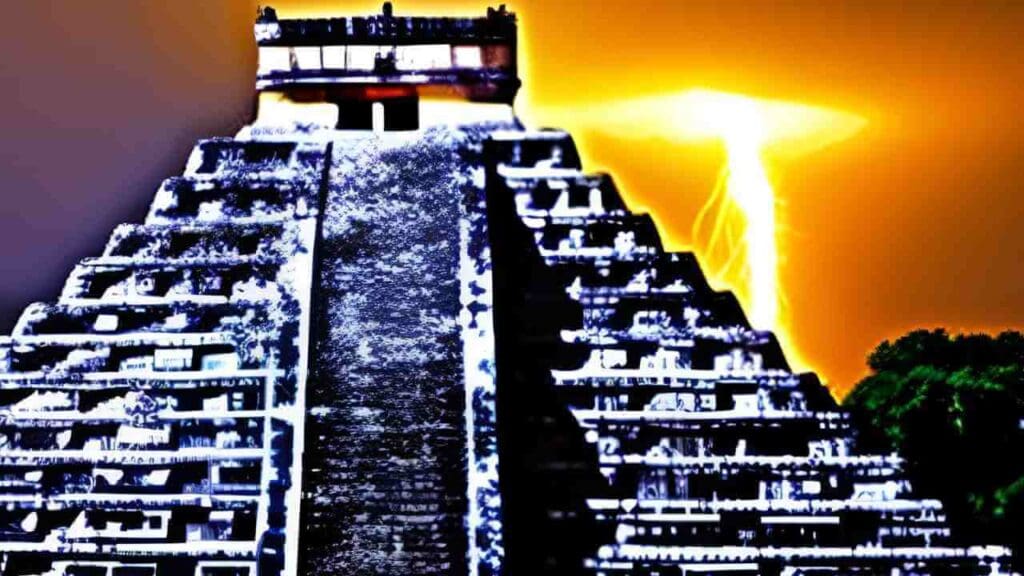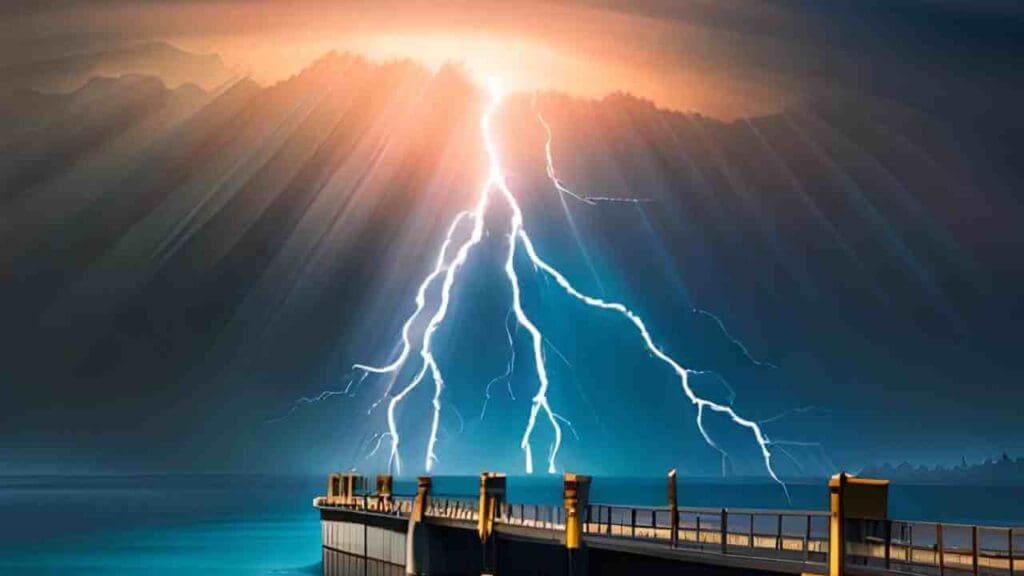Thunderstorms have always held a special place in human hearts, not just as amazing displays of nature, but also as symbols of something greater than ourselves.
Different cultures have their unique perspectives on thunderstorms, viewing them as more than just natural phenomena.
From Hinduism to Norse mythology, from Zoroastrianism to Shinto belief, thunderstorms have been associated with divine forces, symbolic meanings, and transformative power.
In this article, we will explore the spiritual meaning of thunderstorms in various cultural and religious contexts, delving into the symbolism and profound insights associated with these majestic displays of nature’s power.
Thunderstorm – A Hindu Perspective

In Hinduism, thunderstorms hold significant symbolism and are closely associated with the god Indra.
Indra is known as the king of the gods in Hindu mythology. He is also considered the lord of thunder and lightning, wielding a powerful weapon known as the vajra or thunderbolt.
In Hindu terminology, thunderstorms are often referred to as “meghadutam,” which translates to “cloud messenger.”
They are seen as divine messages sent by Indra to cleanse and purify the earth.
The thunder and lightning that accompany these storms are believed to be the manifestation of Indra’s power and presence.
In Hindu mythology, there is a story involving Indra and a demon named Vritra.
According to the myth, Vritra had acquired immense power and used it to wreak havoc on the gods and humanity, causing droughts and blocking the rivers.
In desperation, the gods turned to Indra for help.
Indra confronted Vritra in a fierce battle.
As the battle raged on, Indra invoked the power of thunder and lightning, hurling his thunderbolt, Vajra, at Vritra.
The impact of the thunderbolt was so mighty that it defeated and killed the demon, freeing the waters and restoring balance to the world.
The thunderstorm in this tale symbolize the divine power that vanquishes darkness, evil, and obstacles in order to restore harmony and prosperity.
Also Read: Spiritual Meaning Of A Sunshower
Thunderstorms as a Symbol of the Battle Between Order and Chaos

In Norse mythology, thunderstorms hold significant spiritual meaning and are closely intertwined with the god Thor, who is known as the protector of both gods and humans.
Thor is known for his immense strength and his weapon of choice, the mighty hammer called Mjölnir. It is through the power of Mjölnir that Thor creates thunder and lightning, making him closely associated with storms.
Thunderstorms were believed to represent Thor’s ongoing battles against the giants, which symbolized the eternal struggle between order and chaos.
The thunder created by Thor’s strikes with Mjölnir was seen as a manifestation of divine power, signifying the forces of order and stability.
It represented the strength and protection provided by Thor against the chaotic and destructive forces represented by the giants.
Furthermore, lightning, which accompanied the thunder, was believed to be a means through which Thor dispelled darkness, ignorance, and malevolent influences.
Thunderstorm was seen as a symbol of divine illumination, dispelling the shadows of ignorance and guiding individuals towards wisdom and enlightenment.
In Norse mythology, thunderstorms also carried symbolic messages related to the cyclic nature of existence.
The battles between Thor and the giants, represented by thunderstorms, signified the perpetual struggle between opposing forces in the cosmos.
It reflected the continuous cycle of creation, destruction, and rebirth, emphasizing the importance of maintaining balance and harmony within the universe.
Thunderstorms in Zoroastrianism

In Zoroastrianism, thunderstorms were considered a manifestation of the power and influence of Ahura Mazda, the supreme deity.
Zoroastrianism is an ancient Iranian religion that originated in the 6th century BCE and was founded by the prophet Zoroaster (or Zarathustra).
According to Zoroastrian beliefs, the world is engaged in a perpetual cosmic struggle between two opposing forces: good represented by Ahura Mazda, and evil represented by Angra Mainyu (also known as Ahriman).
Thunderstorms were seen as one aspect of this ongoing battle.
In Zoroastrian mythology, thunder and lightning were considered symbolic of Ahura Mazda’s power and were associated with the divine forces of good.
Thunderstorms were believed to be manifestations of Ahura Mazda’s energy and the defense against the forces of evil.
The symbolic significance of thunderstorms in Zoroastrianism can be understood within the context of the religion’s dualistic worldview.
Thunderstorms were seen as a demonstration of the divine power supporting righteousness and fighting against the forces of darkness.
Thunderstorms as a Source of Guidance

In Mayan culture, thunderstorms were seen as significant events and were believed to carry messages from the gods.
The Mayans had a deep reverence for nature and believed that natural phenomena, including thunderstorms, held spiritual significance.
Mayan society was highly connected to agriculture, and they relied on the rains for the success of their crops.
Thunderstorms were seen as powerful expressions of the gods’ will and were believed to contain messages and teachings for the people.
During a thunderstorm, the Mayans believed that the gods were communicating with them.
The thunderous sound was seen as the voice of the gods, and the lightning was interpreted as a divine sign.
These phenomena were believed to convey messages, warnings, or prophecies that required attention and sometimes action from the people.
Mayan priests and shamans played a vital role in interpreting these messages from the gods.
They would observe the patterns of thunderstorms and other natural phenomena to understand the gods’ will and provide guidance to the community.
The messages conveyed through thunderstorms were often interpreted as instructions to make changes, perform rituals, or seek appeasement for any perceived transgressions.
Thunderstorms as a Symbol of Zeus’ Power

In Greek mythology, thunderstorms were believed to be caused by Zeus, the king of the gods. Zeus was considered the most powerful deity and ruled over the heavens and the earth. He was often depicted as a wise and mighty figure, wielding a thunderbolt as a symbol of his authority.
When Zeus was angered or wanted to assert his power, he would unleash thunderstorms upon the world. The sound of thunder was thought to be the rumbling of Zeus’ chariot as he traveled across the sky, while the flashes of lightning were seen as his powerful bolts hurled down from the heavens.
One famous story that showcases Zeus’ association with thunderstorms is the myth of Prometheus.
Prometheus, a Titan, stole fire from the gods and gave it to humanity, which angered Zeus.
In retaliation, Zeus punished Prometheus by chaining him to a rock and sent thunderstorms to torment him.
Each thunderclap represented Zeus’ wrath and served as a reminder of his dominion.
Another well-known myth is the story of Odysseus, a hero of the Trojan War, and his encounter with Polyphemus, a Cyclops who was the son of Poseidon, Zeus’ brother.
When Odysseus and his men blinded Polyphemus, Poseidon was enraged and sought revenge.
As a result, Zeus sent thunderstorms and violent seas to hinder Odysseus’ journey back home, demonstrating Zeus’ power over the elements.
These myths and stories illustrate the belief that thunderstorms were seen as manifestations of Zeus' authority and his ability to control the forces of nature. They served as reminders of Zeus' power and his role as the king of the gods in Greek mythology.
The Power of Thunderstorms in Shinto Belief

In Shintoism, thunderstorms are associated with the Raijin, the god of thunder.
In Shinto belief, thunderstorms are viewed as sacred occurrences with deep spiritual meaning and symbolism.
They are believed to cleanse impurities and bring forth positive energy and blessings.
Raijin is responsible for thunder, lightning, and storms in Shinto mythology.
He is often depicted as a fearsome figure with a muscular body, carrying drums that he beats to create thunderous sounds.
The crashing sound of thunder is believed to be the result of Raijin’s powerful drumming.
In Shintoism, thunderstorms are seen as a means of purifying the world and dispelling negative energies.
The force and intensity of thunder are thought to shake loose impurities and evil spirits, allowing for a renewal of spiritual energy.
The lightning that accompanies thunderstorms is seen as a divine force that illuminates the darkness, revealing hidden truths and bringing clarity to the world.
The symbolism associated with thunderstorms in Shintoism can be seen in various myths and cultural practices.
One such story is the legend of Susanoo, the Shinto god of the sea and storms.
Susanoo once encountered a monstrous serpent called Yamata-no-Orochi that terrorized the land.
To defeat the creature, Susanoo used the power of thunderstorms, specifically lightning, to weaken and slay the serpent.
This story highlights the association between thunderstorms and the divine power to overcome challenges and bring about positive change.
In the religion of Shinto, thunderstorms symbolize a powerful change that purifies and renews the world, creating opportunities for fresh starts and blessings.
Thunderstorm Symbolism in Native American Culture
Many Native American tribes have a spiritual connection to thunderstorms, considering them as manifestations of spiritual energy and power.
Thunderstorms are believed to be accompanied by sacred beings such as the Thunder Beings or Thunderbirds, who are seen as bringers of renewal, purification, and spiritual transformation.
While specific beliefs and stories can vary among different tribes, here are some Native American traditions associated with thunderstorm symbolism.
Lakota Sioux: In Lakota Sioux tradition, thunderstorms are linked to the Thunder Beings, powerful spirits associated with thunder and lightning. The Thunder Beings are believed to bring blessings, cleansing the land and the people of negativity and impurities. They are respected and revered for their strength and transformative power.
Ojibwe: The Ojibwe people view thunderstorms as a time of renewal and healing. It is believed that during a thunderstorm, the Thunderbirds descend from the sky, bringing rain to nourish the earth and cleanse it from any negative influences. Thunderstorms are seen as a time for spiritual growth and personal transformation.
Navajo: In Navajo tradition, thunderstorms hold great significance. Thunder is associated with the deity Tó Neinilii, who is believed to bring rain, fertility, and blessings. The rain from thunderstorms is seen as a purifying force that restores balance and harmony to the natural world.








